Census.gov > Library > Infographics & Visualizations > 2013 > Synthetic Work-Life Earnings by Field of Bachelor’s Degree and Occupation Group for Full-Time, Year-Round Workers Whose Highest Attainment is a Bachelor’s Degree
Library
Synthetic Work-Life Earnings by Field of Bachelor’s Degree and Occupation Group for Full-Time, Year-Round Workers Whose Highest Attainment is a Bachelor’s Degree
April 4, 2013

A bachelor’s degree holder can expect to earn about $2.4 million over his or her work life. However, not everyone with the same college major and level of education earns the same amount. Engineering majors make the most of any college major, at $3.5 million, but this varies widely between engineering majors who work in service occupations ($1.4 million) and those who work in management occupations ($4.1 million). Education majors make the least, at $1.8 million, and no occupation for education majors provides higher earnings than the average for bachelor’s degree holders. For more information on the classification of fields of degree and occupations, see www.census.gov/library/publications/2012/acs/acsbr11-04.html.
For related graphics see the series of infographics showing Pathways After a Bachelor’s Degree see: www.census.gov/library/visualizations/2012/comm/pathways-series.html
SOURCE: Julian, Tiffany, "Work-Life Earnings by Field of Degree and Occupation for People With a Bachelor’s Degree: 2011," American Community Survey, U.S. Census Bureau, October 2012, available at www.census.gov/library/publications/2012/acs/acsbr11-04.html.
NOTE: Colors represent statistical difference from the average for all bachelor’s degree holders—2.4 million. Synthetic work-life earnings represent expected earnings over a 40-year time period for the population aged 25-64 who maintain full-time, year-round employment the entire time. Calculations are based on median annual earnings from a single point in time for eight 5-year age groups multiplied by five. Not all fields of degree and occupations are shown here. Data based on sample. For information on confidentiality protection, sampling error, nonsampling error, and definitions, see www.census.gov/programs-surveys/acs/.
Recent Data Visualizations
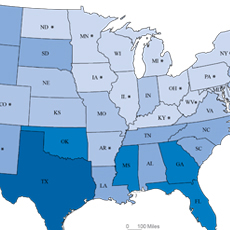 Population Without Health Insurance
Population Without Health Insurance Population Bracketology
Population Bracketology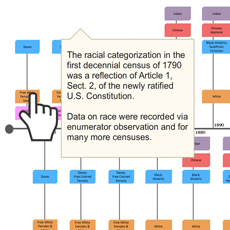 Measuring Race and Ethnicity Across the Decades: 1790-2010
Measuring Race and Ethnicity Across the Decades: 1790-2010 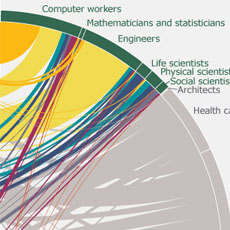 Where do college graduates work?
Where do college graduates work? Story Maps Illustrate Population Change
Story Maps Illustrate Population Change HIV/AIDS Impact in Africa
HIV/AIDS Impact in Africa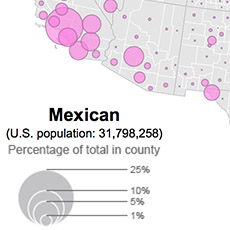 Distribution of Hispanic or Latino Population by Specific Origin: 2010
Distribution of Hispanic or Latino Population by Specific Origin: 2010 A Century of Population Change in the Age and Sex Composition of the Nation
A Century of Population Change in the Age and Sex Composition of the Nation 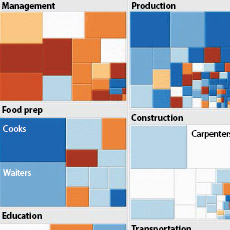 Shifting Occupational Shares
Shifting Occupational Shares Metro Area Density
Metro Area Density Work-Life Earnings
Work-Life Earnings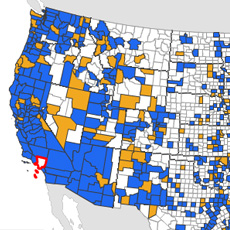 Census Flows Mapper
Census Flows Mapper Migration Between Calif. & Other States
Migration Between Calif. & Other States U.S. Territory and Statehood Status
U.S. Territory and Statehood Status Spoken Languages Other than English
Spoken Languages Other than English Center of Population, 1790-2010
Center of Population, 1790-2010 Population Change by Decade
Population Change by Decade Without A High School Education
Without A High School Education A Decade of State Population Change
A Decade of State Population Change State-to-State Migration for States of 8 Million or More
State-to-State Migration for States of 8 Million or More Population Under 5 Years Old by Congressional District
Population Under 5 Years Old by Congressional District Components of Metro Area Change
Components of Metro Area Change Blooming States
Blooming States Coastline County Population
Coastline County Population Coastline County Population
Coastline County Population I-90 Population Density Profile, 2010
I-90 Population Density Profile, 2010 Second Cities: Keeping Pace with a Booming New York
Second Cities: Keeping Pace with a Booming New York By the Grid: Population Shift to the West and South
By the Grid: Population Shift to the West and South I-10 Population Density Profile, 2010
I-10 Population Density Profile, 2010 Booming Cities Decade-to-Decade, 1830-2010
Booming Cities Decade-to-Decade, 1830-2010 I-5 Population Density Profile, 2010
I-5 Population Density Profile, 2010 Islands of High Income
Islands of High Income The Great Migration, 1910 to 1970
The Great Migration, 1910 to 1970 Following the Frontier Line, 1790 to 1890
Following the Frontier Line, 1790 to 1890 Changing Ranks of States by Congressional Representation
Changing Ranks of States by Congressional Representation Cartograms of State Populations in 1890, 1950, and 2010
Cartograms of State Populations in 1890, 1950, and 2010 Before and After 1940: Change in Population Density
Before and After 1940: Change in Population Density From Physical to Political Geography
From Physical to Political Geography Differential City Growth Patterns
Differential City Growth Patterns I-95 Population Density Profile
I-95 Population Density Profile Increasing Urbanization
Increasing Urbanization Gaining and Losing Shares
Gaining and Losing Shares Top 20 Cities
Top 20 Cities




